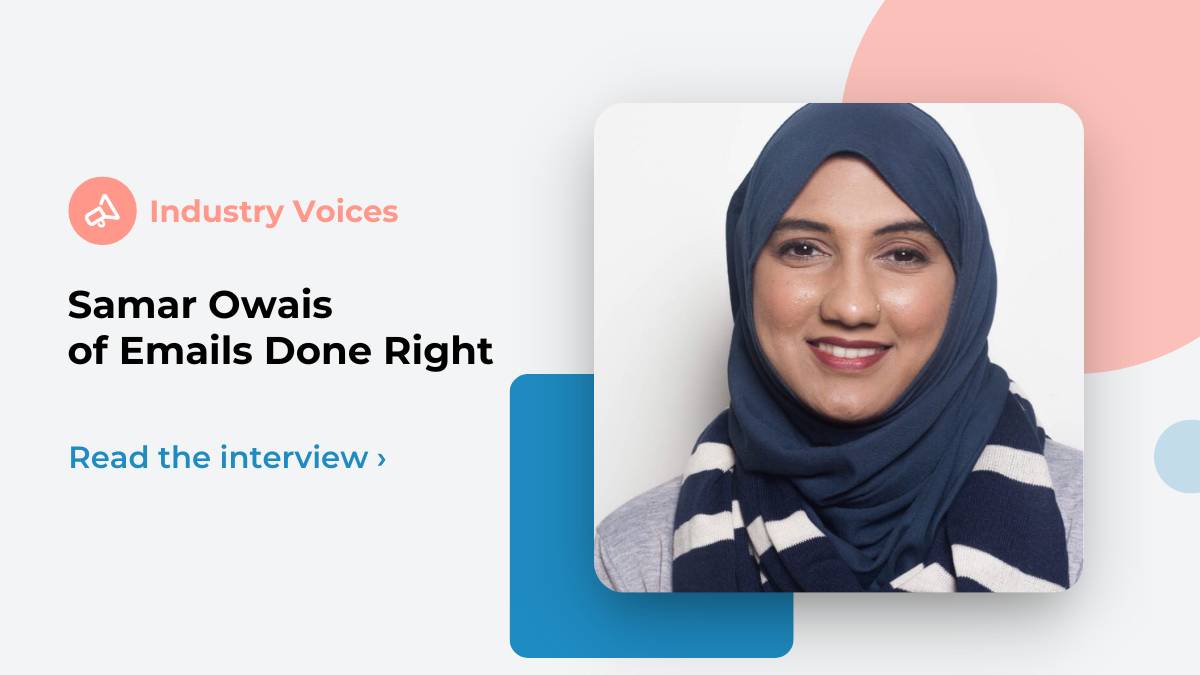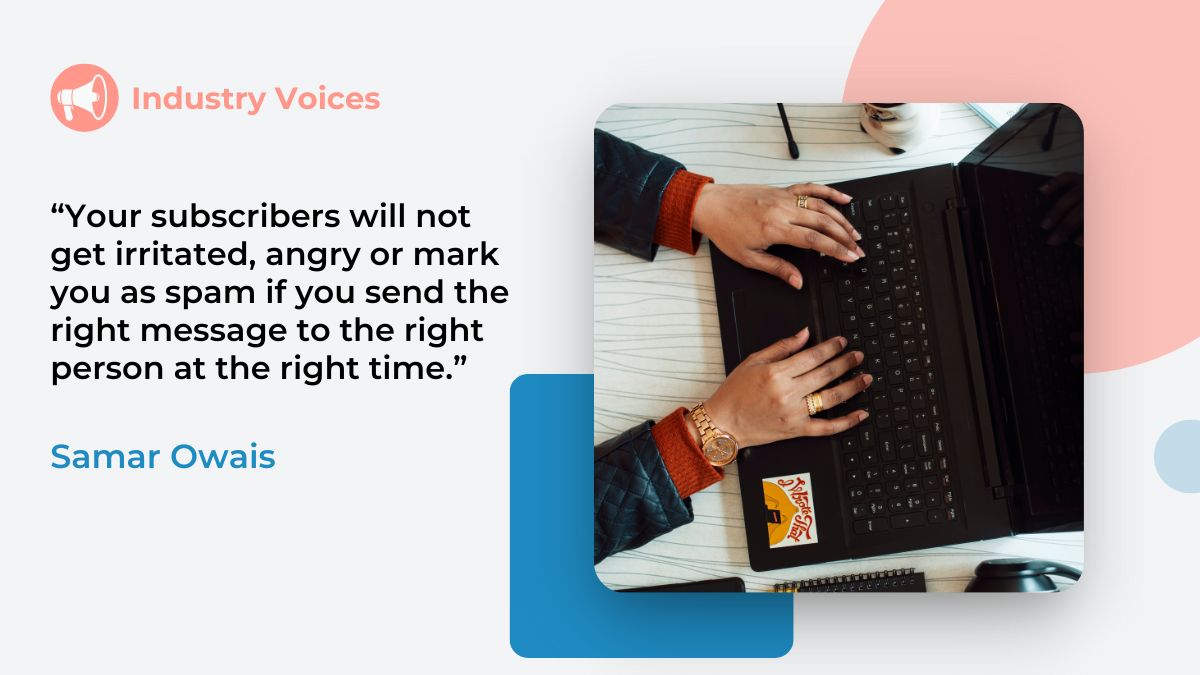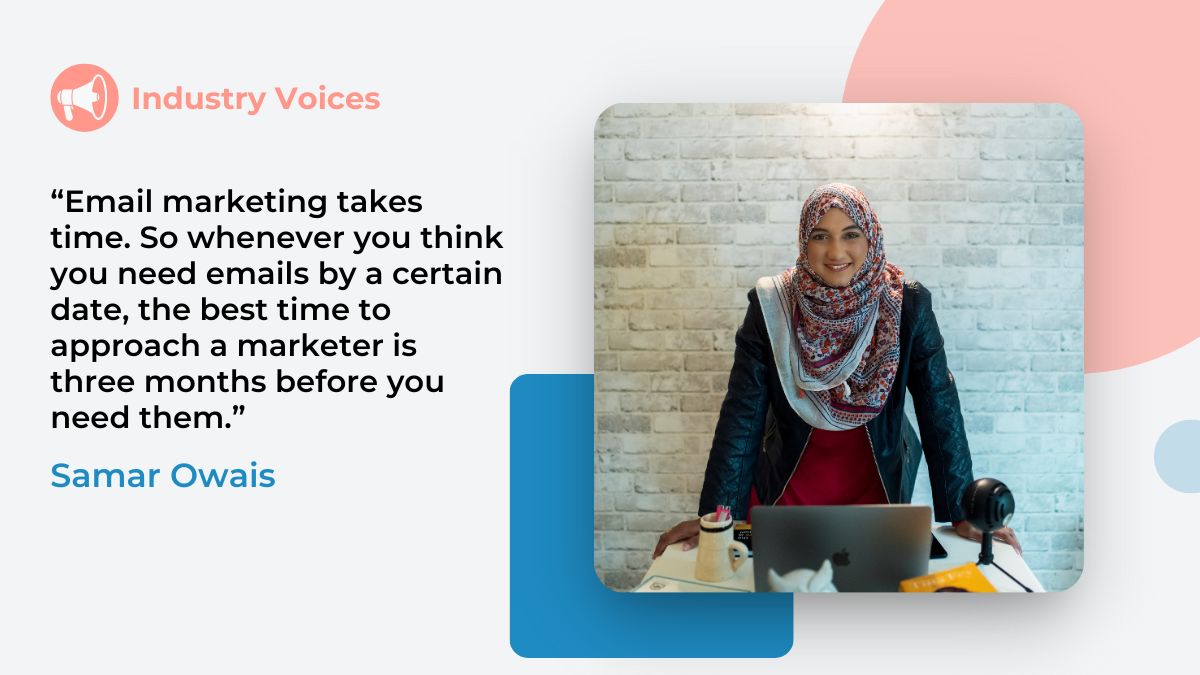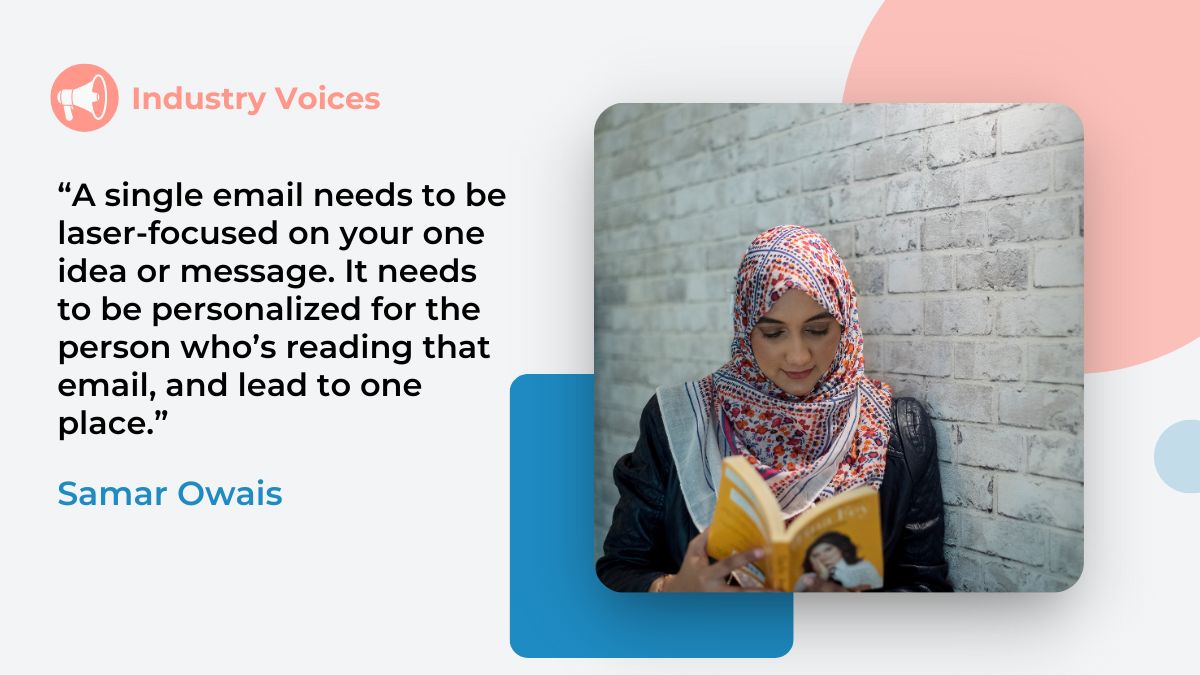
Samar Owais, Email Strategist – On Getting Better Email Results with The Rule of “One”
Email strategist and copywriter Samar Owais talks to ZeroBounce about building better email marketing programs and simplifying our approach with the rule of “One.”
We edited this interview for readability and clarity. Want to watch it instead? Just scroll down.
As an email marketer, many of your goals seem hard to attain. Like, how do you turn those subscribers into true fans?
You want to increase conversions, but how do you do it? How do you get that person who signed up for a free trial to commit to being a paid subscriber?
Samar Owais is a teacher at her core and has a way of demystifying all of this. She is a SaaS and e-commerce email copywriter and strategist and is always on the front lines of the email world.
The founder of Emails Done Right has written content for renowned brands like Marriott and InterContinental and entrepreneurs like Paul Jarvis.
Read on to find out:
- How to win with welcome emails
- What high-value content really boils down to
- Samar’s three-point “Rule of One” for every email she sends.
Thank you for joining us, and I also want to thank Emily Ryan, another well-known person out there in the email world. She highly recommended you as a great person, all around, in email.
Emily’s great! I love her Sunday newsletter. There are some email links in there, but the rest of it is just a perfect round-off to a weekend where you sometimes just want to browse and look at cool stuff.
She’ll send you a list of cool things she saw across the week, and it’s just such a joy not to have to do my own browsing and sometimes look at cool things – plus an email hack here and there.
It’s one of my favorite newsletters out there.
I have to concur. Now, I’ve been reading some of your emails lately. As a writer, what would you say has been one of the best teachers for you?
Really dissecting the copywriters I admire, just dissecting their work.
Early in my career, Copyblogger was a huge inspiration source. And, yes, their content was great, but also the caliber of the writing. I would notice certain things. There used to be a writer there called Demian Farnworth. He’s such a good writer, and while reading his work, I would ask myself, why do I love reading his posts?
Then, I would sit down and take notice of things. He would introduce an idea in the intro. And then he would bring us back to it in the conclusion and kind of close the loop on that thought. It created such a perfect package that made me feel like: “Hey, I’ve got all this info, and now there’s like a neat little bow tie on it. And I feel like it’s contained.”
So I would notice these little quirks, tricks and copywriting tactics that other writers would use. Then I’d practice it in my own work. Just observing other copywriters’ work has been a great teacher.
What is the best recipe for confidence when you’re a writer?
Failing. It’s a recipe for confidence, no matter what you’re doing.
For copywriting, or writing in general, failing helps. The more you do it, the better. Get those bad, shitty drafts out of your system. And then, when you write that piece of really good copy or that really good email or that really good web copy page… it is just such a joy.
I don’t know about other writers, but when I write a really good piece of copy after laboring over it for hours or days and sometimes weeks, I go back again and again and read it just to remind myself how good I am and how good that piece of copy was. I still go back.
I’ll come across certain things that I wrote a few years ago or some of my earlier emails when I’m sending somebody my samples or portfolio, and I’d think: this is still good work.
And so there’s residual confidence coming in also that, “Hey, I was good then. Even when I didn’t think I was. I’m on the right track and have improved so much.”
So confidence for me comes from doing the work.
Now I want to talk about your study with the original conversion copywriter, Joanna Wiebe. What would you say was one of the more valuable things that you learned from Joanna Wieb?
I didn’t study copywriting with Jo. I studied business with Jo.
Joanna Wiebe had a business course called 10 x Freelance Copywriter. It teaches you all about running your own business, building your own authority, how to market yourself and how to work with clients.
The one thing that Jo taught me was this phrase that she often says to students who are hesitating, who know what they need to do but are hesitating because they’re scared or shy or have these mindset issues.
It was: “Put your big girl pants on.”
And she said it to me so often that it’s always in my subconscious now. Every time I step out of my comfort zone and I don’t want to. Every time I do something for the first time and I’m crap at it. I don’t want to do it because I’ve tasted what being an expert feels like, but I know it’s important for my business or my growth.
Jo wrote this on Slack channels, emails and other places. It rings in my head. “Put your big girl pants on and just do the damn thing.” And I do it because when your mentor’s voice is in your head that often, you do it.
Especially because you know it works, right?
Because I do the work so often, and that’s been my thing for doing my business. I realize that it doesn’t necessarily get easier or better, but once you’ve faced your fear, it’s not that it’s less scary the next time. It’s that you have survived once, and you know you can survive it again. Or you can face that fear again, at the very least.
Eventually, there will come a time when you do things long enough that you don’t fear them anymore because then it becomes muscle memory.
Can you give us an example of something you used to be afraid of that’s now “muscle memory”?
The perfect example of that would be discovery calls.
When I started, in 2018, I took my business full-time and pivoted into email marketing. I started getting on video calls with clients. Before then, I was a content writer and would mostly conduct my business through email because I was very shy. I’m still socially awkward.
I don’t know how to make small chitchat. I’m very awkward with that. And so, I had all the other head trash that comes with being a very visible Muslim copywriter working in the US market. I had all that head trash around me and did not want to get on video calls. And then that was the first time Jo told me to put my big girl pants on.
The first discovery call was so bad. I was reading off of a script. You could tell that I was reading off of a script. I was shaking. Overall, it was one of the worst calls I’ve ever had. But doing that the first time, I realized I’d done it.
I never want to do it again. But if I have to, I know I can. That’s what I do whenever I’m scared or stepping out of my comfort zone. Just face it once.
What you just said is going to resonate with a lot of people. A lot of people like to talk about the really great emails. There’s even Really Good Emails.
But I want to tell you about an email that I got a few days ago. Every now and then, I’ll notice one, and I won’t name the company, but it was so bad that it’s worth mentioning as an example. I signed up to a money newsletter, and the welcome email was: “You will now begin receiving emails from us. TY,” which I think means “thank you.”
Yeah.
This is a big company, and I thought, wow, I think they missed it. So how can someone make welcome emails better?
Oh, God. Okay. The easiest way to improve a welcome email is to look at where people are signing up. You’re making them a promise.
You are making an offer to encourage people to sign up, so just continue that conversation. Make it about the reader.
So people signing up for a money newsletter are obviously signing up for it for a bunch of reasons: they want to educate themselves. They want to do better at finances.
Maybe they want to save more money. They may want to invest more or be smarter investors. Whatever the newsletter is about: just reiterate all the benefits of reading those newsletters and remind them that the decision they made to sign up was the right decision.
Make them feel good about the action that they’ve just taken.
So I mentioned these things:
- A: continue the conversation that started on the opt-in form, landing page or Facebook ad – wherever they’re signing up from.
- B: make them feel good about themselves. Make them feel that they know this was the right decision to make.
- C: deliver whatever promise you made.
If you promise them money-saving tips, give them one quick tip, right? So that they can get a taste of what’s to come.
That is very good advice. There’s something that I see a lot, especially when different email marketers converse with one another. People are trepidatious about sending too many emails. What can you tell us about how often to send an email to your list?
Oh, this is a good question. At the minimum, once a week, please. Because so many clients or brands will come to me and say, we don’t want to offend our subscribers. But what they fail to account for is that when somebody subscribes to your newsletter, they’re actually telling you: I want to hear from you.
Tell me about your business.
Tell me about your products.
Tell me more about whatever the topic is of the newsletter.
They’re implicitly giving you permission to email them, and if you don’t email them regularly, you are squandering an opportunity. So, at a minimum, land in your subscribers’ inboxes once a week.
Unless your newsletter is “Hey, here’s everything that happened this month.” Then obviously, it’s a monthly newsletter. You don’t want to be sending it every week, but if it’s a general newsletter, send it once a week.
If you’re an e-commerce brand, you can totally up it two-three times a week. If you’ve got a big list and you’ve got a lot of segmentations, you can do five days a week.
Your subscribers will not get irritated, angry or mark you as spam if you send the right message to the right person at the right time. So if somebody signed up to your newsletter, they should be receiving the welcome emails and nothing else.

If somebody just bought something from you, they should receive the post-purchase emails. They should not receive any other offer emails until they’ve been delivered that one product they ordered from you.
So make sure that the customer journey or the email journey is properly mapped out so that you can send:
- the right email
- to the right person
- at the right time.
You’ll hear this again and again and again in the email space: be sending high-value content. What is the best way to create this high-value content that everybody wants?
People make it harder than it needs to be.
First of all, every business out there is creating content. All you have to do is repurpose it for email. So if you’re an e-commerce brand, you’re already doing social media posts, testimonials, product stories, landing pages and user-generated content that you can repurpose into emails.
Secondly, if you have a personal brand like me, all you have to do is talk about how you do things. A lot of times, that’s enough because high-value content is what? It’s teaching somebody something, right? But it doesn’t mean that it has to be so jam-packed with value that you give it all away in one single email.
So keep it concise to one idea per email, and everything is connected. We all have so many ideas. We all have so many things that irritate us about our industries. Write about that.
Repurpose podcast interviews like this one. Half of this stuff will get turned into my newsletters because all the questions you’re asking me are great. They are questions I know other people have.
I will turn those things into my newsletters. Or I’ll turn them into my LinkedIn posts. Sometimes I will have an idea for a LinkedIn post and realize: “Oh, I haven’t written an email about it in a while or at all.” And I will then turn it into an email.
Everything is connected, and everything is a content idea.
Is it more common that an email is too serious, or is it more common that an email is too silly?
It’s more common that an email is too serious. They come from a perspective of the email being all about the business, not the subscriber. So they’re too focused on the wrong side of the screen.
I always say that you could have a list of a hundred thousand subscribers, but the person reading your email on the other end of the screen is just one. And it doesn’t matter whether you’re a B2C business or a B2B business. The person reading your email is just one.
If you don’t focus on them, it’s not going to connect you with your audience. Many times people make the email about themselves and not their subscribers, which is where the serious part comes in.
In watching and listening to some of the other interviews you’ve done, you’ve commented that the email marketer is the one who sets the expectations. That is such an interesting point. Why is it so important?
As email marketers, we know we sit in the middle. We are the middleman between the business and the subscriber or the customer.
I may be working with a brand, a SaaS company or an e-commerce brand, but I’m advocating for your customers. Because when you put them first and when you focus on their email experience or customer experience, it’s going to serve my clients better.
Founders have a lot on their plate. Marketing teams are overwhelmed with things they need to do. Only some people have the bandwidth to think about email in the way that I do because it’s my job.
I get to set very realistic expectations in terms of timeline, in terms of met performance and in terms of the metrics to track because I have been doing this stuff for a while.
When I work with a brand, my entire job is to take the pressure off the founder or the marketing team and manage it for them. Everybody’s heard that stat, right? For every $1 you spend, you can expect anywhere between $36 to $44 of return or ROI. And that number changes every single year.
I don’t know what it is this year, but it tends to yoyo between $36 and $44. So they expect just to start sending emails and think they’ll get these great returns. That’s not true. To get that ROI, you need to do a bunch of things. Otherwise, it’s just like sending emails for the sake of sending emails.
Part of my job is setting expectations that way. Like, you want an onboarding sequence? That’s great, but getting and creating that onboarding sequence involves:
- getting the customer research that we need to do
- figuring out what their trigger moments are
- and determining what is going to convince them to become paying users.
All of that involves customer research, and customer research takes time. It’s going to take anywhere between four to six weeks, if you’re lucky, and six to eight weeks if you’re not. And then comes the email strategy part, and next comes the email copywriting part. So we’re looking at anywhere between 10 to 12 weeks on a project.
So if you want onboarding emails, you cannot expect to get them within two weeks or a month ’cause there’s so much involved that goes into it. Similarly, let’s say you’re selling products. If you’re an e-commerce brand, even then it will take time.
There are so many other factors involved. When we set up a welcome email flow, it depends so much on how much traffic you’re getting on your website and how much of it is converting into newsletter subscribers.
If your list isn’t growing? I can set up the perfect welcome flow for you, but it will not convert if not enough people are signing up.
So all of these things I must talk about and set expectations. Then, once all your lifecycle emails are set up, it is going to take time for your emails to gain traction because we’re also getting our subscribers used to hearing from us.
We’re getting them used to reading our emails and expecting our emails. A lot of times, when I do an email strategy and I do the content plan for a weekly news center for a brand, we come up with themes and figure out what themes will be relevant to those subscribers.
For example, it’s summer in the US right now. We’re going to start the back-to-school season very soon for brands that serve that market. That’s not just school bags, stationery and books. It’s also snacks. It’s also Lunchables, right? And a lot of other things that people need.
Email marketing takes time. So whenever you think you need emails by a certain date, the best time to approach a marketer is three months before you need them.

We learn so much from our failures, yet people are often afraid to try something new. Has there ever been a time when you tried something a little bit risky with email? What happened when you did that?
Oh, yeah. An e-commerce brand reached out to me nearly two months before Black Friday and Cyber Monday. They said, “We’ve been in business for three years. We haven’t grown our list, but we’ve been selling through ads and getting traffic on our landing pages and ads. We’ve got a list of 25,000 customers that we want to send out a Black Friday promo.
And I was like, “Okay.”
And they said, “We know we don’t have a list, but these are people who were automatically added to the list. These are people who knew that they were being signed up, all of that. We’d love to sell to them.”
I thought: that’s great. It’s all in the email strategy. I’ll create a strategy for you that will engage your subscribers. Then we’ll sell.
So I created a whole email strategy for them that was warming up their list. It was creating a wait list that was an “early bird” offer. It was a wait list and then a proper offer to the actual offer, to the entire list.
I thought we’ve got two months. We’ll be fine. I didn’t consider how hard it is to engage a cold list and how long it takes. So we did not make any money on that promotional campaign. We broke even, and I am so thankful we broke even. But honestly, I consider that a failure on my part because my client was able only to cover the expense.
So they paid for the designer, they paid for the strategy and the copy with me and a bunch of other stuff. When I checked in with them to see how they had done, they said “We broke even. We didn’t have a loss.”
But I was so ashamed of myself for being so cocky. I told my client we could do this and then was faced with the cold, harsh reality of how hard it is to engage an audience.
Email takes time. That was one of the lessons I learned: no matter how great your strategy is, it will not work if you do not engage your email subscribers regularly.
Samar’s Rule of “One”
Is there a copywriting formula that you use in email that works best?
Yes, but I don’t know if I’d call it a formula.
Whenever I’m writing an email, I have a three-point checklist that is always at the back of my hand:
- One idea or message per email.
- One reader.
- One type of call to action.
One message or idea per email means that we are keeping our emails laser-focused.
If it’s a sales email, that’s the entire focus. What is that one sales angle that I’m going for? I’ll stick to it.
If it’s a content email, what is that piece of content or idea that I want to share? And I will stick to it. My emails are typically very, very short.
My newsletter is “Emails Done Right.” Those emails are typically less than 300 words because I share one idea. Three hundred words are more than enough to get people to start thinking about your idea. Again, that person on the other side of the screen is one reader.
So yes, I have a list that’s small, but let’s say I have a list of 2,000 people, right? I’m sending that email to 2,000 people, but I need to write it in a way where the person reading it feels like I’m talking directly to them.
When I say one type of call-to-action, I mean that your email can absolutely and should have multiple CTA. One could be a hyperlink, one could be a button.
But it all needs to lead to the same place because the more different types of calls-to-actions we include, the more we dilute. If you have more than one thing to ask of people, send more emails.
But a single email needs to be laser-focused on your one idea or message. It needs to be personalized for the person who’s reading that email, and lead to one place. It needs to ask for that one action, whether that’s to read a blog post or to buy a product, or to download something. Just one type of CTA.

At ZeroBounce, our bread and butter is email validation – removing bad data from email lists. Would you say that many of your clients know about data decay, or how quickly an email list could go bad?
A lot of people have let their list go stagnant. When somebody says “I haven’t emailed my list in a few years,” my first instinct is to tell them to scrap it and start anew.
Because in three years, your business is very different from what it looked like three years ago. You have changed topics, you’ve changed niches, all of that.
The other thing that I want to do is tell them to run a re-engagement sequence. I’m not a deliverability expert, but it’s one of the things that I always say you need. I tell clients they need to talk to an expert about it.
You have to weigh your options.
Ask: “Is it better for us to reengage a list that is that cold and hurt our list? At that point, it has already been hurt. But if you send an email after a three-year break, you will be marked as spam. Your domain is probably not warmed up. Is it better to start anew at that point?
It then becomes a business decision for my client. What do they want to do?
Let’s say they decide, “We want to try and keep as many of these people as we can.” Now, the technical side of it could be different, where we may get a new domain, transfer everybody, and things like that.
But the part that I specialize in is the email strategy for it. What will our strategy be to re-engage those subscribers? The first thing we want to do is cull everybody who’s not interested.
So you remind them who you are, tell them what your newsletter is about and set expectations for what’s to come. Then you give them the option to either click to stay or click to unsubscribe. Then you take it from there.
What’s coming up on the horizon with Samar?
Oh, lots of things. I’m speaking at Litmus Live in September, in Boston.
Then I’m traveling to Mexico to attend a conference where I will be learning things because the last quarter of the year is always when I plan for the next year. I find that a well-picked conference with people who are ahead of human business or are in the same industry as you will help you figure out things much faster.
When I finally started going to conferences, I realized one was for networking and speaking. One was for this stuff like doing the work. The last part is always where I think about what I will do next year. Last year when I did this work, I realized I wanted to slow down.
So this year, I really slowed down. I’ve continued doing podcasts, webinars, interviews and workshops. I was overworked and exhausted, so my client workload has really slowed down this year.
I teach courses about email strategy for both SaaS and E-commerce, and last year, I launched that course. It’s a live training that’s cohort-based, so there’s a lot of one-on-one involvement. I was tired and thought, I’m not launching a course, but because I love teaching, I started feeling angsty.
So I thought, you know what? What if I just do a master class? I did a masterclass and enjoyed it, but then that was it, I was done.
I’m taking it slow this year. Nothing on the horizon other than gearing up and preparing for next year. I’ve had my year of slow, of relaxation, of working at leisure, and now I’m gearing up to take on more client work, teaching more courses, all of the fun stuff.
Connect with Samar Owais on LinkedIn.
Table of Contents
- Thank you for joining us, and I also want to thank Emily Ryan, another well-known person out there in the email world. She highly recommended you as a great person, all around, in email.
- I have to concur. Now, I've been reading some of your emails lately. As a writer, what would you say has been one of the best teachers for you?
- What is the best recipe for confidence when you're a writer?
- Now I want to talk about your study with the original conversion copywriter, Joanna Wiebe. What would you say was one of the more valuable things that you learned from Joanna Wieb?
- Can you give us an example of something you used to be afraid of that’s now “muscle memory”?
- What you just said is going to resonate with a lot of people. A lot of people like to talk about the really great emails. There's even Really Good Emails.
- But I want to tell you about an email that I got a few days ago. Every now and then, I'll notice one, and I won't name the company, but it was so bad that it's worth mentioning as an example. I signed up to a money newsletter, and the welcome email was: “You will now begin receiving emails from us. TY,” which I think means “thank you.”
- This is a big company, and I thought, wow, I think they missed it. So how can someone make welcome emails better?
- That is very good advice. There’s something that I see a lot, especially when different email marketers converse with one another. People are trepidatious about sending too many emails. What can you tell us about how often to send an email to your list?
- You’ll hear this again and again and again in the email space: be sending high-value content. What is the best way to create this high-value content that everybody wants?
- Is it more common that an email is too serious, or is it more common that an email is too silly?
- In watching and listening to some of the other interviews you've done, you've commented that the email marketer is the one who sets the expectations. That is such an interesting point. Why is it so important?
- We learn so much from our failures, yet people are often afraid to try something new. Has there ever been a time when you tried something a little bit risky with email? What happened when you did that?
- Samar’s Rule of “One”
- At ZeroBounce, our bread and butter is email validation – removing bad data from email lists. Would you say that many of your clients know about data decay, or how quickly an email list could go bad?
- What’s coming up on the horizon with Samar?






